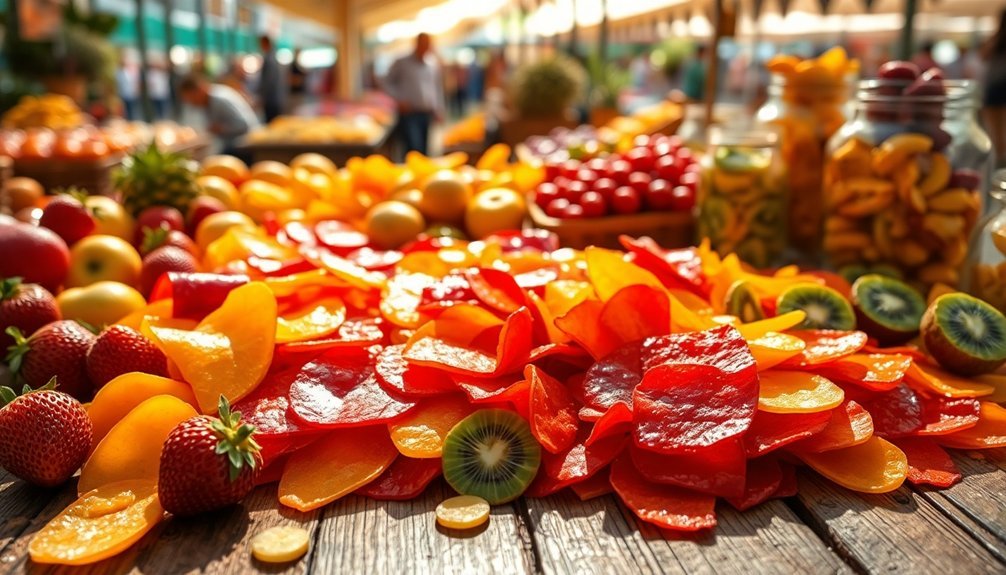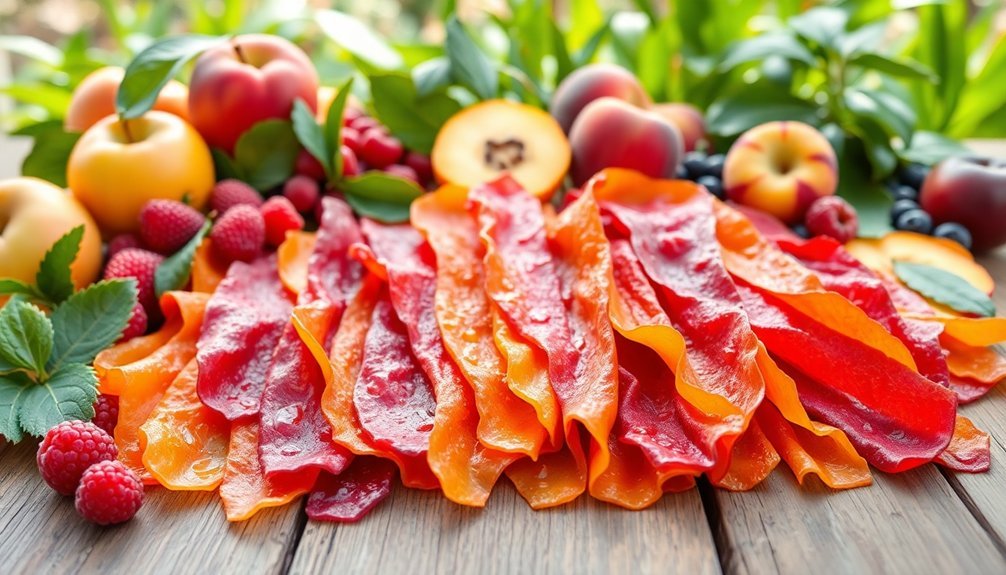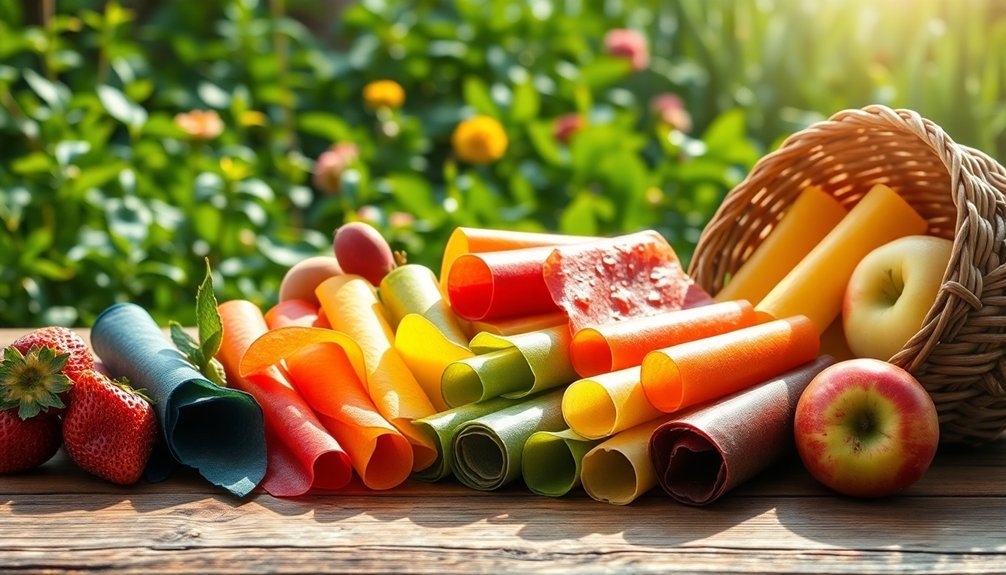Fruit leather production is booming because you're increasingly choosing healthier snacks. With its low fat and high fiber content, fruit leather fits your lifestyle perfectly. Plus, it's made from 100% organic ingredients, appealing to your desire for sustainability. Advanced technology also boosts efficiency and quality, ensuring delicious flavors and a longer shelf life. You benefit from a product that not only minimizes waste but also supports local economies and reduces your carbon footprint. This trend isn't slowing down, so stick around to discover how it's reshaping the snack industry.
Rising Consumer Demand

Riding the wave of increased health consciousness, consumers are turning to fruit leather as a go-to snack option. You're likely seeking healthier, natural alternatives to traditional snacks, and fruit leather fits the bill perfectly. Packed with fiber and low in fat, it's a nutritious choice that appeals to your wellness goals. The growing awareness of organic foods means you might prefer 100% organic fruit leather, which enhances its appeal. Additionally, the demand for 100% organic ingredients reflects a strong trend among health-conscious consumers.
Convenience plays a significant role in your snack choices, too. Fruit leather is lightweight and easy to pack, making it ideal for your busy lifestyle—whether you're heading to work, school, or on an outdoor adventure. Parents love it for school lunches, as the easy-to-open packaging is perfect for little hands.
Flavor variety adds another layer of attraction. You can choose from a wide range of delicious fruit combinations, spices, and even customizable sweetness levels. This versatility caters to your taste preferences, ensuring you never get bored.
With the global fruit snacks market growing, it's clear that the rising consumer demand for fruit leather is here to stay.
Technological Innovations
You'll notice that advanced manufacturing techniques are revolutionizing fruit leather production. Innovations in material development are also enhancing the quality and shelf-life of the final product. Together, these technological advancements are shaping a more efficient and sustainable industry. Additionally, the use of fruit leather helps to reduce reliance on traditional leather, further emphasizing the environmental benefits of these innovations.
Advanced Manufacturing Techniques
Advanced manufacturing techniques are revolutionizing the production of fruit leathers, streamlining processes and enhancing efficiency. Automation and robotics play a significant role, using robotic handling to manage delicate products and high-speed packaging machines that can wrap up to 400 items per minute. Specialized equipment like dehydrators guarantees ideal drying conditions, while precision in temperature control prevents the darkening of fruits. Proper drying helps to ensure the shelf life of the finished product, allowing it to last up to 9 months if stored correctly.
Here's a quick overview of the key technologies:
| Aspect | Details |
|---|---|
| Automation | Delta robots for efficient product handling |
| Drying Equipment | Ovens and dehydrators for various scales |
| Production Efficiency | Batch preparation and improved drying times |
| Scalability | Flexible packaging solutions for diverse products |
These advancements, including the integration of vision systems and custom-designed trays, enable year-round production. You can produce fruit leathers in a way that maximizes quality and maintains shelf life. With thorough training and local support, you'll find it easier than ever to adopt these technologies, ultimately contributing to the booming fruit leather market.
Material Development Innovations
As the demand for sustainable alternatives grows, innovations in material development for fruit leather are transforming the industry.
You'll find that producers are selecting durable fruits like bananas and pineapples, which not only enhance the quality but also reduce waste by utilizing skins often discarded due to imperfections. This approach is resource-efficient, requiring less energy than traditional leather production.
The processing techniques have also evolved. After washing and straining, additives like sugar and citric acid are introduced to improve flavor and shelf life.
Drying methods vary, ensuring the final product has ideal moisture content and a flexible texture, thanks to pectin. Sodium bisulphite plays a vital role in preserving color during processing.
Moreover, fruit leather's versatility allows it to mimic traditional leather styles while providing breathability and comfort, making it suitable for everyday items.
By applying waterproofing treatments, it becomes even more practical. These innovations contribute to a circular economy, reducing food waste while providing an eco-friendly and animal-friendly alternative.
With its nutritional value and sensory attributes, fruit leather stands at the forefront of sustainable product development.
Environmental Advantages

While traditional leather production poses significant environmental challenges, fruit leather offers a sustainable alternative that prioritizes resource conservation.
You'll find that producing fruit leather requires fewer resources, like water and energy, compared to conventional leather manufacturing. By utilizing waste products from fruits, this process not only reduces the need for new raw materials but also promotes sustainable consumption patterns.
Fruit leather encourages the planting of more trees, helping to combat deforestation while reducing pressure on ecosystems. Its lower carbon footprint is another vital advantage; it cuts down on greenhouse gas emissions linked to livestock farming and minimizes land use and energy consumption. By sourcing its ingredients locally, it further mitigates climate change impacts.
Moreover, fruit leather production avoids toxic chemicals, ensuring a safer working environment and less environmental pollution. By upcycling agricultural byproducts like fruit skins and peels, you're contributing to waste reduction and supporting a circular economy.
This process transforms what would typically be discarded into durable materials. Ultimately, fruit leather not only provides a delicious treat but also represents a commitment to sustainable practices that protect our planet.
Market Growth Projections
How fast is the market for fruit leather and other bio-based alternatives growing? You'll be intrigued to know that the global bio-based leather market is projected to reach USD 535.69 million by 2034, with an impressive growth trajectory.
By 2024, the market size is expected to hit USD 145.26 million. The plant-based leather market, valued at USD 18.58 billion in 2023, is on track to soar to USD 44.13 billion by 2032.
From 2023 to 2028, the bio-based leather market is anticipated to grow at a staggering CAGR of 15.0%, indicating robust demand for sustainable materials. As consumers seek eco-friendly options, segments like pineapple-based and cactus leather are set to experience significant growth.
Europe currently leads as the largest market for both bio-based and plant-based leather, and it's likely to maintain this dominance.
The regional growth is fueled by a commitment to sustainability and innovative production practices. With applications across various sectors, including fashion and upholstery, the market for fruit leather and its bio-based counterparts is clearly on the rise, reflecting a shift toward environmentally conscious consumerism.
Regulatory Support

What role does regulatory support play in the growing fruit leather market? Regulatory support is vital for guaranteeing food safety and encouraging sustainable practices. While there aren't specific regulations for fruit leather production, general food safety guidelines help maintain quality and consumer trust.
- Governments provide essential equipment through support programs.
- Competitions from organizations like UNDP and Japan offer financial aid for production setup.
- Accredited labs conduct pesticide testing to guarantee compliance with safety standards.
- Recommendations focus on minimizing pesticide exposure for healthier products.
- Non-discrimination policies guarantee equitable access to agricultural programs.
The lack of stringent regulations on pesticide use in conventional farming raises concerns about residue levels in fruit leather. Although organic produce regulations exist, they don't fully eliminate the risk of contamination from nearby fields.
This is where accredited laboratories, such as Anresco Laboratories, come in, testing products to guarantee they meet safety standards. Compliance with these standards not only protects consumers but also bolsters the market's integrity.
Economic Benefits
As the fruit leather industry grows, you'll see a surge in job creation opportunities, especially in sustainable sectors.
This expansion not only helps reduce waste by utilizing agricultural byproducts but also boosts local economies through new businesses and innovations.
With these economic benefits, it's clear that fruit leather production is making a meaningful impact.
Job Creation Opportunities
Capitalizing on the increasing demand for healthy snacks, the fruit leather production industry is set to create numerous job opportunities. As consumers seek nutritious options, this sector is experiencing growth, leading to a stable workforce and a variety of roles.
Here are some key job creation aspects:
- Diverse Roles: Positions range from production line workers to quality control specialists.
- Skilled and Unskilled Positions: Both types of labor are essential, ensuring opportunities for a wide range of skill sets.
- Local Economic Boost: Manufacturing plants contribute to local economies through increased spending and tax revenues.
- Supply Chain Growth: Jobs in procurement, transportation, and logistics are expanding, supporting the production process.
- Government Support: Initiatives like the USDA's "Farm to School" program promote local sourcing, fostering job creation in agriculture and manufacturing.
With around 169,100 employees in the food preserving sector, the future looks promising.
As the market for sugar-free fruit leathers expands, the industry not only aids health-conscious consumers but also plays a pivotal role in job creation, benefiting both individuals and local economies.
Waste Reduction Strategies
The fruit leather production industry not only creates jobs but also implements effective waste reduction strategies that bring significant economic benefits. By converting leftover and slightly overripe fruits into valuable materials, you can help reduce the estimated 10% waste that occurs during import, transport, and retail.
This process not only minimizes waste but also aligns with circular economy principles, effectively managing the large amounts of organic waste generated from fruit production.
Moreover, fruit leather requires fewer resources compared to traditional animal leather manufacturing. This eco-friendly process uses biodegradable materials, cutting down on pollution and enhancing worker safety.
You'll also find that it reduces costs associated with waste disposal, making it a cost-effective alternative to conventional leather products.
Local Economic Growth
Fruit leather production is driving local economic growth by creating job opportunities and boosting revenue for farmers. As the industry expands, you'll find numerous benefits for your community, including:
- Job Creation: The production process generates employment across various stages, from fruit collection to packaging.
- Market Expansion: Growing demand opens new market niches, both locally and abroad, leading to increased sales.
- Increased Revenue: Local farmers gain extra income by selling surplus or waste fruits to manufacturers, enhancing their profitability.
- Contribution to Local GDP: The industry bolsters the local economy, creating new businesses and increasing tax revenues.
- Sustainable Practices: By tapping into the eco-friendly trend, local businesses can thrive while promoting sustainable agriculture.
With companies like Fruitleather Rotterdam hiring for roles in manufacturing and research, the job market is diversifying.
This boom not only supports local farmers but also enriches the community by reducing unemployment rates.
As fruit leather production flourishes, it paves the way for a robust local economy, enabling you to invest back into sustainable practices and further growth opportunities.
Social Impact

Many people may not realize the profound social impact of fruit leather production on both the environment and animal welfare. By utilizing unsold or discarded fruits, fruit leather production greatly reduces food waste, addressing a global crisis.
It requires far fewer resources—like water and energy—compared to traditional leather manufacturing, which helps lower the overall carbon footprint. Plus, it promotes a circular economy by turning waste into valuable materials and avoids the toxic chemicals often used in animal leather production, thereby reducing pollution.
From an animal welfare perspective, fruit leather eliminates the need for animal slaughter, offering a humane alternative. It protects endangered species by not relying on animal hides and mitigates the negative impacts of livestock farming.
Consumers increasingly seek ethical products, and fruit leather meets this demand, providing a cruelty-free option that's also better for the planet.
On a broader scale, fruit leather production creates economic opportunities and jobs in regions with considerable fruit waste. It encourages sustainable consumption patterns and raises awareness about food waste, influencing wider trends toward eco-friendly practices and sustainability in consumer goods.
Diverse Applications
Often overlooked, the diverse applications of fruit leather extend far beyond the domain of snacks. You might be surprised to learn how versatile this product can be across various industries.
- Fashion and Textiles: Used in shoes, bags, upholstery, and even clothing.
- Nutritious Snacks: High-energy options for school lunchboxes or outdoor activities, made from fruits like apples and berries.
- Innovation in Technology: Advanced production processes enhance durability, such as using polyurethane in products like AppleSkin™.
- Natural Sweetener: Acts as a flavoring agent in cooking and baking, offering a healthier alternative.
- Sustainable Practices: Collaborations to upcycle agricultural byproducts and reduce post-harvest loss.
These applications demonstrate that fruit leather isn't just a delicious treat. It's becoming a staple in fashion, food, and innovative tech solutions.
As companies explore new ways to incorporate fruit leather, you'll see its presence grow beyond your pantry and into your wardrobe and kitchen. The possibilities are endless, and the impact is significant. Embracing these diverse applications could change how you view fruit leather altogether!
Sustainable Practices

In recent years, sustainable practices in fruit leather production have gained considerable attention, reflecting a growing demand for eco-friendly alternatives to traditional leather. You'll find that these practices contribute to a low carbon footprint, avoiding the high emissions linked to raising and processing animals. By eliminating toxic chemicals and using organic materials, fruit leather production minimizes environmental impact and supports energy-efficient methods.
Moreover, fruit leather utilizes waste from the fruit juice and cider industries, actively reducing waste and promoting a circular economy. By upcycling discarded fruit, it helps combat food waste while lowering landfill contributions. As a consumer, you're playing a role in this sustainable shift.
Water conservation is another key aspect. Fruit leather production requires considerably less water than both traditional and vegan leather, often using organic dyes that enhance water-saving efforts. This approach tackles water pollution issues commonly associated with leather tanning processes.
Lastly, you can feel good knowing that fruit leather production prioritizes animal welfare. By using plant-based materials, it avoids animal cruelty and promotes ethical practices that align with your values for sustainability and compassion.
Frequently Asked Questions
What Types of Fruits Are Commonly Used for Making Fruit Leather?
When making fruit leather, you can use apples, apricots, plums, and various berries. Tropical fruits like mangoes and pineapples work well too. Combining high and low pectin fruits helps achieve the perfect texture.
How Does Fruit Leather Compare in Price to Traditional Leather?
Fruit leather's production costs are considerably lower than traditional leather. You can make it at home for about $1.04 per batch, while traditional leather can exceed $150 for just a small piece.
Can Fruit Leather Be Customized for Different Applications?
Yes, you can customize fruit leather for various applications. Choose different fruits, adjust sweeteners, mix in vegetables, and experiment with spices. You can also decide on shapes and storage methods to suit your preferences.
What Are the Shelf Life and Storage Requirements for Fruit Leather?
Fruit leather lasts 1-2 months at room temperature, up to a year frozen. Store it in airtight containers, away from moisture and direct sunlight. Refrigeration extends its life considerably, maintaining flavor and texture.
Are There Specific Certifications for Sustainable Fruit Leather Products?
Yes, there are specific certifications for sustainable fruit leather products, like the Global Recycled Standard and Forest Stewardship Council. They guarantee responsible sourcing, eco-friendly practices, and safe production, helping you choose environmentally friendly options confidently.
In Summary
To sum up, the boom in fruit leather production reflects a perfect blend of rising consumer demand and innovative technologies. With its environmental benefits and diverse applications, it's no surprise that this market is thriving. Plus, regulatory support and economic advantages make it an appealing choice for businesses and consumers alike. Embracing sustainable practices not only enhances your lifestyle but also contributes to a healthier planet. So, why not join this delicious trend and enjoy the benefits of fruit leather?





Leave a Reply